|
Mount
McKinley
Archive
of Past Articles
‘Forever on the Mountain:’ a McKinley saga
Forever on the Mountain: The Truth Behind One
of Mountaineering’s Most Controversial and
Mysterious Disasters
by James M. Tabor
W.W.Norton, New York, 2007. $26.95
| Joe Wilcox never met Dr. Frederick Cook, but they
do have an interesting connection. Both led
expeditions and climbed Mount McKinley. Both of
their expeditions generated controversies that have
simmered for many years. And both men were at or
near the top of the late Brad Washburn’s enemies list
for decades while this reviewer achieved the
distinction only much later and for a much shorter
period.
Readers of
Polar Priorities know how the doctor
made the list, but Wilcox used a different route. As a
youthful 24-year old graduate student, he organized
an expedition with a program to establish simultaneous
camps on McKinley’s North and South Peaks. Wilcox
then wrote to the expert, Washburn, asking if this had
ever been done before. He also requested an
expeditious reply since there was media interest in his
plan. |

>
READ THE FULL ACCOUNT
|
The Return to the Summit
Russian Jubilee Expedition to
Mt. McKinley confirms 1906 route
By Dr. Dmitry Shparo and Oleg Banar
Two Russian expeditions to Alaska, organized by the Adventure Club of Dmitry and Matvey Shparo and the Vokrug Sveta magazine of Moscow convincingly demonstrated that one hundred years ago on September 16, 1906 Dr. Frederick Cook had reached the summit of Mt. McKinley, the highest peak of the North American continent.
See
the diary of their
expedition on our Polar
Priorities page.
 |
“Mt. McKinley, by sheer altitude, not by latitude, pushes its ice-bejeweled
crown into the realm and research of the Boreal midnight sun. For centuries the
Indians watched with awe and admiration this midnight midsummer fire in all its
crowning glory above the clouds, while the lower slopes were bathed in the chilly
blue of the sub-Arctic night. For this reason, if for no other, Mt. McKinley is the
world’s most remarkable mountain.”
Dr. Frederick Cook, 1912
|
The Controversy Begins
On April 21, 1908, Dr. Frederick Cook, a well-known American explorer, accompanied by two Inuits– Ahwelah and
Etukishook, congratulated each other with having reached the North Pole. Dr. Cook had discovered the northern-most point of the world, where meridians come together and the latitude equals 90 degrees. He announced that there was no open sea, as many scientists thought, nor was there a volcanic island as recounted by Jules Vern’s fictional hero, Captain
Gatteras. There were only drifting fields of endless ice.
A year later on April 6, 1909 renowned explorer Robert Edwin
Peary, also arrived at the top of the world. The return of Dr. Cook had been delayed for more than a year and only on September 1, 1909 this possessor of the “grand prize” sent a telegram to the Secretary of the International Bureau for Polar Research: “Reached North Pole April 21, 1908”. (2)
In five days on September 6, 1909 the editor of the
New York Times read the similar message from Robert
Peary: “I have the Pole April 6, 1909… arrange to expedite transmission big story”. (3)
Dr. Cook’s reaction to the announcement of Robert Peary was quite friendly: “My feeling at the news, as I analyze it, was not of envy or chagrin. I thought of Peary’s hard, long years of effort, and I was glad; I felt no rivalry about the Pole; I did feel, aside from the futility of reaching the Pole itself, that Peary’s trip possibly might be of great scientific value; that he had probably discovered new lands and mapped new seas of ice. There is glory enough for all, I told the reporters”. (4)
>
READ
THE FULL ACCOUNT
Cook's
grand-daughter at McKinley
site on Centennial of the
first climb in 1906
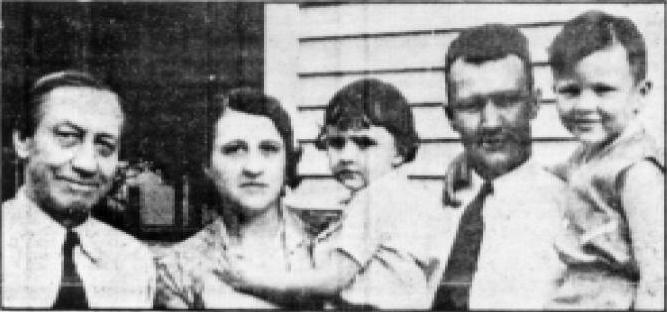
East
Aurora, NY, July
1937: Dr. Cook visits
with Ruth and her husband,
Robert Hamilton. Bette is held by her mother
and Robert Jr. is at right.
Ruth Glacier, discovered by Cook in his 1903 reconnaissance of Mt. McKinley, was named after his younger daughter. His grand-daughter Bette visited the mountain at Denali National Park 100 years after his first ascent.
Bette Hamilton Hutchinson, grand-daughter of Dr. Frederick A. Cook, visited the site of what many believe to be his second-greatest exploration achievement, the conquest of North America’s highest mountain on the 100 anniversary of his pioneer climb.
Bette, a long-time member of the board of the Frederick A. Cook Society and an associate member of the American Alpine Club as well as the American Polar Society, recalled her experience this past September:
“Denali National Park was vibrant with fall colors (yellow Aspen, green spruce, multi-color low tundra shrubs and flowers) for the four hour trip to our main vantage place for viewing Mt. McKinley. We caught glimpses of the mountain through the trees and hills, and our hopes were high with the cloudless sky and bright sun that we would be among the 30 per cent of visitors who get to see the summit.
“Psychologically I was prepared for disappointment, but I was not prepared for what I did see. When we reached Stony Point we looked across the autumn tundra and saw the mountain in all its glorious splendor. With the sun high in the sky and snowfall the previous day, the shadows on the mountain radiated like a finely-cut diamond. Later I found that I was not the only person in the group taking pictures through our tears. We understood why McKinley is called the crown jewel.
“Searching through bookstores for a photo or painting of what we saw I was told that no photographer or painter has yet been able to capture the magnificence of the mountain at its greatest splendor.
“Further enhancing the experience was knowing that I stood before the mountain 100 years after my grandfather, Dr. Frederick A. Cook reached the summit. Happy Anniversary Grandpa.”
Russians
follow Cook
to Traleika Col
on McKinley's east ridge
The
Russian expedition
which sought to follow
Cook's 1906 route on
the east ridge of Mt.
McKinley reported that
on September 19 of
this year they reached
the Traleika Col
"and
were convinced that a
descent here is quite
possible...and that we
have reaffirmed our
belief that Dr. Cook
made the ascent by
this route."
 |
 |
| Oleg Banar |
Viktor
Afanasev |
| These
two Russian clumbers
claim some of the
top records in their
country, Baner
having led more than
150 mountaineering
expeditions and
Afanasev has been
nominated as the
Russian
mountaineering
champion on three
separate occasions. |
Two
well-known Russian
climbers. Oleg Banar
and Viktor Afanasev,
were part of the
expedition sponsored
by the Adventure Club
of Moscow with the
support of the popular
magazine, Vokrug Sveta.
The party was
organized by Dmitry
Shparo and Matvey
Shparo as a research
expedition.
Matvey
Shparo had led the
2002 Russian McKinley
expedition of eleven
climbers;, two of them
mobility-impaired (who
utilized wheelchairs
in everyday life) to
the summit. Banar and
Afanasev were among
them, and the feat
inspired world-wide
attention with the
inclusion of disabled
mountaineers. Their
replication of the
Traleika Col route was
the first since Cook
99 years ago, and also
included
identification of the
sites of Cook's igloo
and where he dug an
ice cave.
Ted
Heckathom, leader of
the 1994 Ruth Glacier
Expedition that
followed Cook's route,
said that from the Col's ridge Verne (Tejas)
and Scott (Fischer)
could see the route to
the top, just as Dr.
Cook had described it.
The
expedition was plagued
with bad weather-the
worst for September in
many years according
to park rangers-having
only four of 18 days
fully clear. The
Shparos indicate that
they will return to
McKinley in Spring of
2006 the Centennial
year of Cook's first
ascent of the highest
point in North
America.
Denali:
"The Great One."
Climbing North America's
Icy Giant
by
Jim Garlinghouse
| "The
adventurer in each
of us yearns to
explore these icy
reaches, where we
seem to get a
broader perspective
on our own
minuteness and, at
the same time, our
own
significance."
Andy
Selters
|
......... |
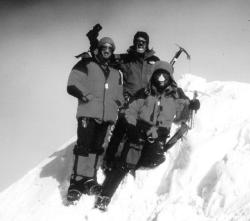 |
A
cold, biting wind whistled
down from the sharp-edged
mountains behind Ushuaia,
Argentina. Zipping my parka
against the cold and
leaning slightly into the
breeze, I made my way
toward a dilapidated phone
booth at the end of the
dock. Moored in its berth
was the Russian ship on
which I had spent the last
three months working as a
naturalist/polar historian,
cruising the continent of
Antarctica. We had arrived
earlier that morning. Now,
with time to kill, I
thought I’d make some
phone calls.
>
READ
THE FULL ACCOUNT
Book
Review:
Dishonorable
history: The last
literary
hurrah of Brad
Washburn |
|

|
The
Dishonorable Dr. Cook:
Debunking the Notorious
McKinley Hoax
by
Bradford Washburn and
Peter Cherici (The
Mountaineers Books, 2001,
192 pages)
Four
years ago Brad Washburn
advised me that he was
writing a book about Dr.
Cook that "would
knock my socks off."
Recently, when this new
book finally arrived, I
tied my shoelaces with
double knots before
opening the odd-sized
volume. A quick glance at
the contents revealed that
book's unusual shape was
to accommodate the
numerous photographs. The
text represents Washburn's
60-plus years of research
about Dr. Cook's
controversial assertion
that he reached the summit
of Mount McKinley in 1906.
>
READ
THE FULL ACCOUNT
The
"Fake Peak"
Serials
1910-1998
|

|
............. |
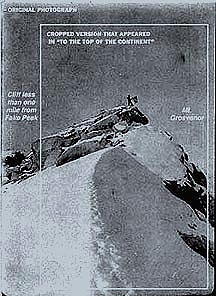 |
Belmore
Browne, 1910
Fake Peak I 1910 |
|
|
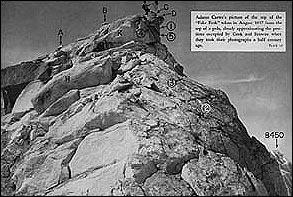
|
|
|
American
Alpine Journal,
1958
Fake Peak II 1957 |
|
As
shown in The New
York Times
Fake Peak III 1998 |
DIO's
Denali Denial & the
Media Campaign for a 'Final
Solution' to Cook as
Discoverer
1
The DIO Genesis
& One-sided Media
'Controversy'
by
Russell W. Gibbons
| On
November 22, 1998
this writer received
a call from a
reporter at The New
York Times asking
for materials which
would support the
claims of Frederick
A. Cook to the first
ascent of Mt.
McKinley in
September 1906. They
were interested, he
said, because of the
"recent"
article in the
Baltimore journal, DIO,
which had earlier in
the year proclaimed
that the
Cook-McKinley
controversy was
"closed"
because of the
research of a
contributor, Robert
M. Bryce. |
......... |
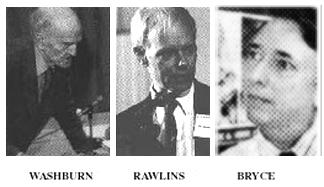 |
It
was the "Final
Solution," declared Dennis
Rawlins,
founder and publisher of
the journal, a critic of
orthodox history of science
with a somewhat mixed track
record for accuracy and
timing (more on this
later). Heading the
cheering section in the
background was the
indefatigable Bradford
Washburn,
spiritual heir to Cook's
critic of his 1906 climb
and the creator of
"Fake Peak," the
89-year-old thesis that was
supposed to have demolished
the explorer, but never
did.
>
READ
THE FULL ACCOUNT
Copyright
2005 - The Frederick A.
Cook Society
|